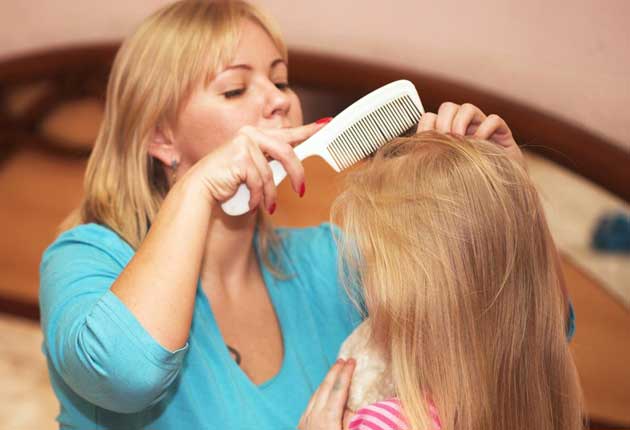How to get rid of head lice
A new school year means it's time to do battle with head lice again. But they can be eradicated – first, you need to know your enemy, explains James McIrvine

Lice are a childhood rite of passage and the bane of parents. The head louse is essentially benign, causing mild itching while feeding, and is not known to carry any serious diseases. Yet the idea of miniscule creatures cheerily gorging on your children's blood is unpleasant and a recent survey revealed that head lice are second only to meningitis in a list of parenting concerns.
Pre-20th century, lice infestation – or pediculosis – was a part of day-to-day life. A wealth of courtly grooming etiquette deals with the subject. In the 1500s, Michel de Montaigne could barely contain his horror for those who'd "crack lice with their teeth like monkeys" (it was far more polite to use your nails), while other chroniclers expressed their disdain for such faux pas as using a fork to scratch your bites at the dinner table.
In modern times the emphasis has understandably shifted from coping to removing, and a selection of treatments is available, some more effective than others. Pesticides have come under the closest scrutiny in recent years. Used freely and not always effectively since their inception, studies have revealed that some strains of lice have become resistant to the most widely-used chemicals. On top of this, there are concerns about the potential health risks of applying insecticides to children's heads.
It is estimated that around three million people a year are subject to lice infestation. Children are the most susceptible due simply to the fact they are far more likely to come into direct head contact with each other. Dr Ian Burgess, director of the Medical Entomology Centre, has been conducting clinical trials on lice for more than 20 years. Does he believe we are, as some sources suggest, in the midst of an escalating pediculosis epidemic? "Levels of infestation certainly increased steeply during the Nineties," he says, "but have flattened out more recently. Epidemiologically, there are only a limited number of people who can be infested at any one time."
So there isn't any need to panic. Though recently Burgess has been finding larger quantities of lice inhabiting individual cases. "It's not uncommon for me to come across boys and their mums say, 'oh, they never get them'. And you put the black comb in and it comes out grey with the bodies of lice." So a willingness to treat the problem is critical and early diagnosis is crucial in preventing the lice from spreading.
With this in mind, the Department of Health has identified 31 October, 31 January and 15 June as "national bug busting" days. This is to encourage parents to check the heads of their offspring thoroughly with a nit comb and, if possible, nip any nits (eggs) in the bud. "Bug busting" is an alternative to pesticides that was branded by the not-for-profit charity Community Hygiene Concern (CHC). The process involves sifting through the hair and removing the lice and their eggs. Root to tip, the process can be lengthy and should be repeated every two days for at least two weeks. Many alternative combs to the "bug buster" brand are available, including electric varieties and a particularly handy type that has corkscrew-shaped teeth.
Dr Burgess points out that combing is time-consuming and far from foolproof. "It needs time, effort, skill and elbow grease. If you're a hard-pressed mum or dad who's struggling with four kids who've all got lice, you can see how they'd have considerable problems." So it's not surprising that the flagship clinical study conducted by CHC achieved only a 57 per cent success rate for eradicating lice in test subjects.
If bug busting fails, NHS Direct recommends pesticides, but this advice could be out of date. "Anyone who's got any nous doesn't use pesticides any more," says Dr Burgess. "During the last nine months most pesticide-based products have disappeared from the UK market. They have been withdrawn because they were not selling enough."
One of the reasons for this has been the introduction in 2005 of new treatments known as "physically active formulations". These are oily liquids that envelop the louse and get into its respiratory system, causing it to perish. Being a non-chemical process, it does not provoke immunity and is not harmful to the patient. So far, in numerous clinical trials, the success rates have ranged from 70 per cent to 97 per cent and Burgess believes that they provide the best method so far for head lice removal.
Crucial to the success of any treatment is repetition. With the first use of any product you are only likely to destroy the lice that are already hatched, leaving a whole new generation unscathed and protected in their eggs. A repeat treatment, seven days later, should break their life cycle.
Significant advances have been made in dealing with the detestable little parasites and it doesn't look like we're in any danger of being overrun by treatment-resistant super-lice. The important thing is for people to diagnose and deal with the problem. Then it's a matter of what works for you. When removing them by whichever method, Montaigne's advice still stands: eating what you find is best avoided.
Subscribe to Independent Premium to bookmark this article
Want to bookmark your favourite articles and stories to read or reference later? Start your Independent Premium subscription today.

Join our commenting forum
Join thought-provoking conversations, follow other Independent readers and see their replies